Stinging Nettles / Spring / Summer / Autumn / Edible
Stinging Nettles are a plant that we’ve all been stung by at some point and, as such, probably remember! There are a few lookalikes, but none of them are dangerous – they just don’t taste as good.
Common Names
Stinging nettles, nettles, common nettle, burn nettle
Botanical Name
Urtica dioica
Scientific Classification
Kingdom – Plantae
Order –Rosales
Family – Rosaceae
Physical Characteristics
The Stinging Nettle is a herbaceous perennial, growing back yearly. Typically groups of male and female plants grow separately. It has widely spread rhizomes that are bright yellow along with the roots.
Stinging Nettle Foraging Video
Stem
The stem grows from 1-2m tall through the summer and dies down to ground through the winter, it’s hollow, ribbed and houses many fine hairs and stinging needles.
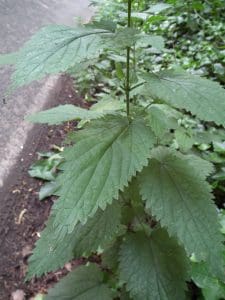
Leaves
Leaves are pale green, turning darker throughout the year – they are elongated heart-shaped, have a wide base and a pointed tip with a heavily serrated margin, growing from 3-15cm and are placed in opposite pairs at right anges to each other up the stem.
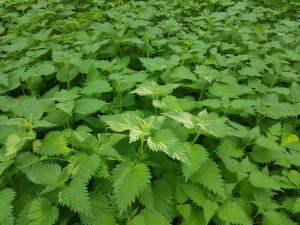
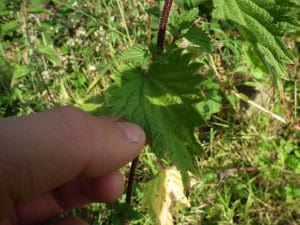
Flowers & Seeds
It bears very small, green flowers in densely packed axillary inflorescences. The male flowers look slightly fluffier and stand out from the main stem, while the female flowers are more angular and hang down with the weight of the seeds as they ripen
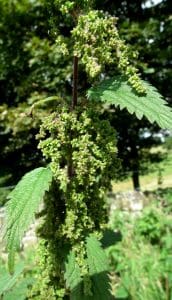
Habitat
One of the most prolific plants throughout the UK, Northern Europe, most of Asia, the United States and Canada. Sometimes struggling further south as it prefers moist soil.
Roadsides, railways banks, waste ground, hedgerows, urban and sub-urban areas, field edges.
Known Hazards
Stinging Nettles are well known for the burning sensation they give if handled reckessly. On the stem of a Nettle stalk are thousands of small needles, typically pointing upwards, with small sacks at the base of the needle. These sacks are filled with various chemicals some of which are acetylcholine, histamine, 5-HT (serotonin), moroidin, leukotrienes, and possibly formic acid.
Could be confused with
Dead nettles (Lamium Purpureum/Album) look similar and can cause quite a shock when picked with no stings. They have square stems, don’t grow as large as Stinging Nettles, they don’t sting and their colourful flowers grow up the stem and look like small bells. The whole of these plants are also edible and if you suck on the base of the flower you can get a nice hit of sweet juice (why the bees seem to like it so much).
Edible Use
Root: herbal use.
Stem: edible when young, becomes fibrous with age.
Leaves young: lacto ferment, spinach sub, crisps, pickled, soups, pesto, sauce.
Leaves old: powdered, cordial, syrup, stock.
Fruit/seeds: edible, roasted, fried.
Click here to see our favourite Nettle recipes
Notes on Herbal Use
Talking to a range of herbalists, it seems that Nettles are the go-to herb for most ailments and they are the lifeblood of current herbalism. Nettle root has been used to help treat prostate cancer and generally helps you keep a healthy prostate. Teas, infusions, creams and tincture are mainly used to help reduce allergies, stimulate digestion, cleanse blood, aid lactation, reduce inflammation, promote menstruation, relieve pain, kill germs, stop hair loss, lower body temperature, increase urination, stop bleeding, dilate blood vessels, lower blood pressure, heal wounds.
The use of Nettles is proven to aid arthritis: although clinical trials isolated a number of chemicals present in the Nettle for tests, traditionally you would hit the desired area with the stinging nettle for up to 20 minutes, causing the heat sensation for a number of hours.
Check out our making medicine blog post here.
Extra notes from the Foragers
Fibres from the stem of this plant make an extremely strong cord and can be spun very finely to also make thread. Interestingly, a number of companies around the world are still looking in to this plant for potential use as cloth and clothing.
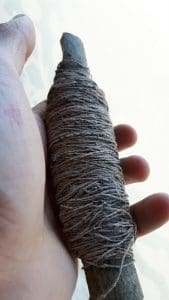



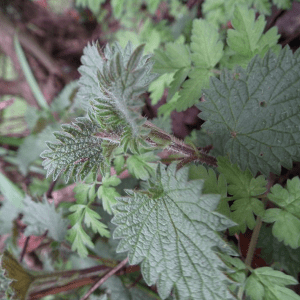
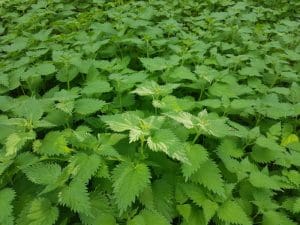
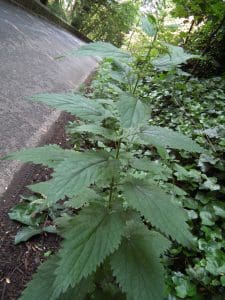
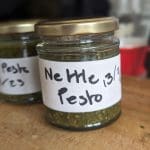
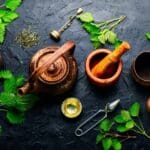
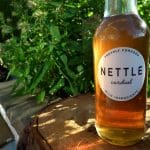



1 reply on “Stinging Nettles (Urtica Dioica) Identification”